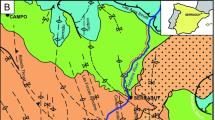Abstract
Down-core variations in illite, chlorite, smectite and kaolinite (the major clays) in two 14C-dated cores collected along the SW continental margin of India show that illite and chlorite have enhanced abundance during 20–17, 12.5, 11–9.5, and 5–4.8 ka b.p., whereas smectite accumulation is higher between 17 and 12.5, and after 9 ka b.p. The climate may have been predominantly arid at 17 (20–17), 12.5, 10.5 (11–9.5), and 4.8 ka b.p. The first three dates correspond to the last glacial maximum, Bolling-Allerod, and Younger Dryas events, respectively. The SW monsoon was variable between 17 and 15 ka b.p., and it was more stable and intense after the Younger Dryas until about 6 ka b.p.
Similar content being viewed by others
Author information
Authors and Affiliations
Additional information
Received: 2 December 1999 / Revision accepted: 11 April 2000
Rights and permissions
About this article
Cite this article
Chauhan, O., Sukhija, B., Gujar, A. et al. Late-Quaternary variations in clay minerals along the SW continental margin of India: evidence of climatic variations. Geo-Marine Letters 20, 118–122 (2000). https://doi.org/10.1007/s003670000043
Issue Date:
DOI: https://doi.org/10.1007/s003670000043



